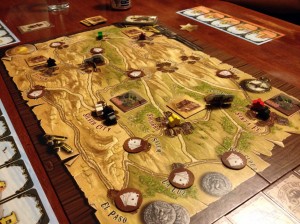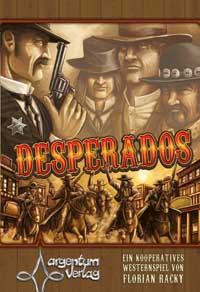Review: Desperados
Posted by James (admin) on November 20th, 2012
 In Desperados, one player is the marshal trying to protect the Wild West from the other players who are all outlaws working together to rob banks, fix poker games and hold-up stage coaches. If the outlaws can gather a total of $4,000 for each outlaw player after 5 rounds, the outlaws win.
In Desperados, one player is the marshal trying to protect the Wild West from the other players who are all outlaws working together to rob banks, fix poker games and hold-up stage coaches. If the outlaws can gather a total of $4,000 for each outlaw player after 5 rounds, the outlaws win.
The gameplay uses an interesting hidden-movement game mechanic as the outlaws try to move to where the sheriffs and marshal are not located so they can steal money and avoid being arrested. (I’ll explain the game mechanic in a bit of detail as it’s the core of the game – it’s actually simple but requires careful explanation.)
GAMEPLAY
The board shows various towns and cities connected by roads – towns have poker game tiles (worth $300-$600), cities have bank tiles (worth $500-$3,200), and stagecoaches move to towns and cities along pre-determined routes (worth $800-$1,200 when robbed). Note that the tiles are random and values hidden so outlaws don’t know exactly what they’re worth.
Wooden figures on the board (meeple) show the locations of each outlaw, the marshal and the sheriffs (1 sheriff per outlaw player). Each outlaw and marshal player has a deck of cards: 1 card showing each town/city plus 1 saloon card. Each of the 5 rounds is split into a planning phase followed by an evaluation phase.
Planning Phase
First, the marshal player can move any sheriffs to adjacent towns/cities and moves the coaches 1 step along their paths. Then, the sheriff lays 1 card face-down which secretly determines which town they will move to next. If it’s the 1st card placed this round, the location must be adjacent to where the marshal’s meeple is located; otherwise, it must be adjacent to the previous card’s location. The saloon card can be used to remain in the same location; however, as there’s only 1 card for each location, the player will have to move around. Next, the outlaws each pick a location to move to in the same way.
A very important gameplay element is that each outlaw has 1 action disc which can be placed once each round. When an outlaw places a card, they can place their disc at that card’s location (revealing the card to the marshal to prove they will be there) but only if there are more outlaws placing discs at the location than there are sheriffs, i.e. 2 or more discs must be placed if there is 1 sheriff present. The action disc can be placed either on the poker game tile (if there’s one at the location), or on the stagecoach (if there’s one at the location). If a player is in a city and doesn’t place a disc, they can scope out the bank to reveal the value of that city’s bank tile (as well as revealing their location card to the marshal).
The marshal and outlaws repeat this process (marshal moves sheriffs, moves coaches & places a card, followed by outlaws placing a card each) 5 times.
Evaluation Phase
Now, the marshal and outlaws reveal their location cards in sequence one at a time, move their figures to the stated locations and resolve any effects. If an outlaw is ever on the same space as the marshal, the outlaw is captured and will not move further or be involved in any actions this round. Also, captured outlaws must give the card matching the location where they were arrested to the sheriff, so they will never be able to enter that city again during the game. (Captured outlaws escape at the start of the next round and can play as normal.)
If outlaws move to where their action discs are, they get to rob the poker game or stagecoach; however, there must be enough outlaws with their action discs present that there would be more than the number of sheriffs that were present when they placed the discs. For example, if 2 outlaws placed discs at a stagecoach when there was 1 sheriff there, both outlaws would need to be present during the evaluation phase for it to succeed – if one was arrested before reaching their disc then the hold-up would fail because there would not have been more outlaws than sheriffs. You can build some contingency into your plans by placing more action discs than the minimum required (so there’d still be enough if one was arrested) but, of course, this means fewer outlaws doing actions elsewhere.
At the end of all 5 movements, any banks where there are more outlaws than sheriffs get robbed and the outlaws take the bank tile. (A new bank tile is added for the next round – note that no new poker tiles ever get added and any robbed stagecoach continues along its journey from the next starting point.)
 THOUGHTS
THOUGHTS
Overall, Desperados is a light, hidden-movement game which is a lot of fun especially as the gameplay is all about working out what you think your opponent will do. The game mechanic reminds me of Dracula’s movement in Fury of Dracula and the gameplay feels like other hidden movement games like Scotland Yard and Letters From Whitechapel – all of which are a good thing. However, Desperados also feels different to these games so it has its own identity and has a great setting to go with it.
At the start of the game, there are lots of options for the outlaws but, as the poker tiles get removed, the action becomes more focused and the marshal has a slightly easier job. However, even though the marshal player can look at the bank tiles at any time so they know which are more valuable, the marshal’s job is never an easy one as it’s quite hard to work out what the outlaws are up to and they have many options. Keeping a sheriff with each stagecoach seems like a good idea, as it makes them harder to hold-up, but then this needs to be balanced with getting sheriffs to cover the cities at the end of each round to stop bank robberies which is also important. So, spread too thin and you can get outnumbered, but bunch up and you can’t cover enough options – it’s a good balance as it creates interesting decisions (in fact, that’s true for both outlaws and the marshal).
When outlaws use their action discs, the marshal gets information on their location. If an outlaw uses an action early in a round then the marshal has a lead on their location/direction so they have more time to try to chase/arrest them; however, using an action later in a round means the marshal knows more about where bank robberies may occur.
As an outlaw, being captured can foil actions; however, the resultant loss of a location card has greater effects than it may seem too (because not being able to visit one location reduces your movement options on parts of the board and can make it difficult to reach locations at a time you want). This means being captured is a concerning threat and gives weight to the marshal’s limited presence so outlaws are scared of the marshal (plus, of course, there’s the smugness of the marshal player who caught you because they read your intentions).
Outlaws can discuss and co-ordinate their plans (in front of the marshal player) by showing cards to each other. Now, you’d think this would make it easy, but it was amazing how our outlawing planning was such a shambles with players suggesting locations and then going somewhere else, or not telling other players the plan had changed. It was humorous and we were more like Disorganados than Depserados.
If the outlaws co-ordinate well, I think the game could be much harder for the marshal player; however, the game could always be made harder for the outlaws by removing some of the highest value tiles, setting a greater win condition, adding an extra sheriff, or removing a random city card per outlaw from the start.
One wishlist item I would have liked would have been some extra rules for an advanced version of the game where the outlaws have a chance of betraying each other too (but that would be a bonus and isn’t a negative). With regards to negatives, the gameplay doesn’t have any major ones. However, there is one big negative which are the English rules as these are very badly translated – there are a lot of typos (both spelling typos and phrases that don’t make sense), but the main issue is that it is actually hard to work out the rules of the game. Even with 5 experienced gamers, it took us a lot of time to work out the rules by reading and re-reading sections as well as discussing them. The problem is that the game flow is badly described, some rules are only mentioned in the examples but not in the main rules description, and other sections are confused because rules are mentioned in places that refer to other game phases so they confuse the issue rather than clarify it.
The weak rules translation is such a shame because Desperados is a good game and I hope this issue doesn’t obscure that from people and people don’t stick with it. A revised set of rules would really help. (Even one of the game designer’s comments on a Boardgamegeek thread trying to clarify the confusing rules doesn’t match what the printed English rules actually say.)
In the end, Desperados is a fun, light, humorously interactive, and relatively quick game with plenty of trying to guess what your opponent is up to. Just remember that the effect of the sheriffs takes place during the planning phase, and the effect of the marshal takes place during the evaluation phase – this may not make sense in terms of realism, but it works really well as a game mechanic which, after all, is what matters.
James.
[Played with 5 players]


September 6th, 2013 at 10:02 am
Excelent review. It helped me getting some clarification about the rules.
September 6th, 2013 at 11:15 am
Cool. Glad it helped. It definitely takes a moment to get your head around how the sheriff and marshals are moved in different time frames.